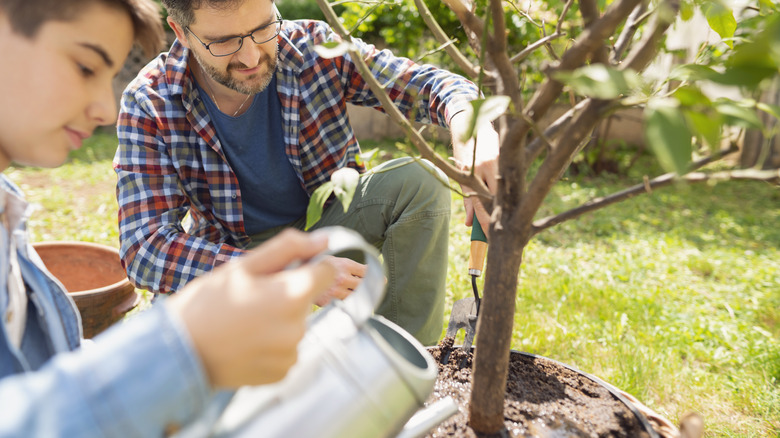One of the tasks unique to home ownership is lawn maintenance. It can be simultaneously a terrible chore and also a huge source of pride. And, overachiever that you are, you took your lawn to a new level by planting a sapling or small tree – maybe even several along a boundary to create a lovely landscaped look. But how do you know your new tree is getting enough water?
Trees can be just as hard to grow as the most delicate houseplants. They require the right climate, sun exposure, soil composition, and hole size. Depending on the varietal, they can be incredibly hardy or terribly high maintenance. There are many mistakes people can make when planting a tree, so as with any gardening endeavor, research is crucial. However, one of the most frequent causes for newly planted trees to die is improper watering. As a general rule, water your trees less often but more thoroughly to get the best results and see your tree flourish and grow throughout the years.
How much water do new trees need?

Experts say that newly planted trees need to be watered more frequently than older trees – as often as 2-3 times per week. Furthermore, the trees need to be watered at the soil level, not the leaves, soaking it thoroughly. This should continue for a full month after planting. After that, continue watering the trees once per week in that same, thorough fashion, for the rest of the growing season. The following growing season, return to that once-a-week schedule. Only after trees have been established for at least two years can you dial back watering to once every two weeks, as needed according to your recent local rainfall.
In addition to following this schedule, there are tools available that can ensure better watering practices. Watering wand attachments and soaker hoses are both recommended for lawn and garden watering. Unlike a harsher spray nozzle, a wand attachment won’t disrupt the soil, or potentially damage the tree bark or leaves because it provides a more gentle flow of water. And soaker hoses – or other DIY watering systems – are great for watering an entire row of plants, such as a border of Arborvitae or a landscaping bed of flowers planted around the base of your new tree.
Troubleshooting an unhealthy new tree
Every type of tree is different, so what works for a Japanese Maple might not be right for your burgeoning fruit orchard. Researching your specific tree species is the best way to find out all its particular quirks and preferences. However, there are some basic ways to tell if your tree is faring poorly and how to get it back on track.
Obviously, dry, brittle leaves and branches are signs of dehydration. If you’re watering the soil around your tree until it’s completely soaked, it’s possible the water is evaporating before the tree’s roots have time to absorb it. In this case, set a reminder to water once in the morning (the ideal time to water all plants) and once again in the afternoon, at least on the hottest, driest days of the summer. On the other hand, spots or other signs of mold and fungus can indicate that your tree is getting too much water. Invest in an inexpensive soil moisture gauge and dial back as needed. Root rot can kill any living plant, no matter the size, indoors or out. Additionally, refrain from watering your tree from the top down, as wet and saturated leaves can invite the very type of diseases you’re trying to avoid. Only the soil needs to be watered because that’s where the roots are. Follow these simple tips and enjoy your trees for years to come.